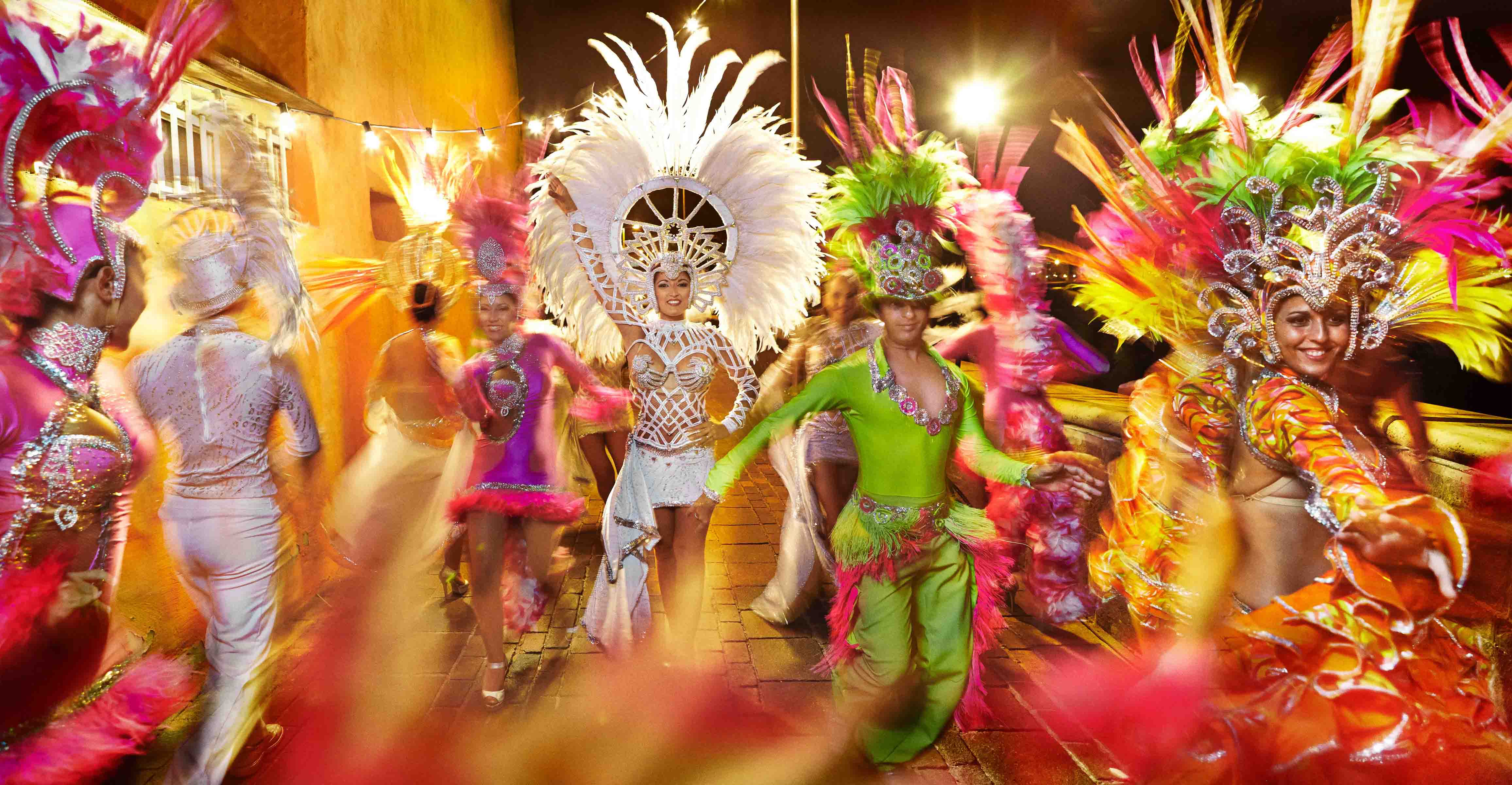
- English
- Español
Spring comes early with Carnival time on the Canary Islands

- The spectacularity of the processions and the originality of the amazing and flashy costumes make carnival time on the Canary Islands “the carnival to end all carnivals”
- Thanks to the year-round mild climate, the archipelago is an attractive setting to host winter’s most traditional and colourful festival
- Intense colours, enormous feathers and glittering beadwork set the Carnival Queens apart, whose costumes can weigh hundreds of pounds
- Humour takes centre-stage in a fiesta full of ingenious murgas (humorous carnival musicians) and carnival groups, talcum powder wars, carnival queens and even drag queens
The Canary Islands, 14 February 2017 – The Canary Islands are already gearing up for one of their most important festivities, with so much flair that it is known as the “the carnival to end all carnivals”. During this lively celebration, the seven islands on the Canarian archipelago are flooded with colour and fun with the spectacular carnival queen contests and their processions and floats, which parade past at a Latin rhythm and the happy and enthusiastic spirit of their participants. The real soul of the Canary Island carnival however, is in their open-air dances, in the squares and streets of their cities, when thousands of residents and visitors enjoy a 24-hour fiesta in which fancy dress reigns.
Despite being held in deep mid-winter, what really make carnival in the Canary Islands different are the pleasant temperatures on the archipelago, given that they stay mild all year round and reach an average of 19 degrees in the winter season, partly helped by long sunny days with clear skies. Even at night the sheerest of costumes are possible to don without worrying about the cold, thanks to the generous climate.
As well as the spring in their step, Canarian carnivals are full of energy and contrasts, just like the archipelago’s unique volcanic nature. On each island many of the towns hold their own celebrations, the majority truly exceptional and original, with a long tradition. Nevertheless, all of them are steeped in a great party environment with highly original costumes that are worn out in the streets as part of a tradition that is passed down from generation to generation.
It is possible to see spectacles such as the carnival queen contest in Santa Cruz de Tenerife (whose magnificent costumes can weigh hundreds of pounds due to the beadwork and enormous feathers covering the outfits), the incredibly fun drag queen shows, popular talcum powder wars and century-old customs that involve getting dressed up in dried-out sheepskins and chasing the public to daub their faces with shoe polish.
The carnivals worth seeing on the archipelago take place over the seven islands. The most important are:
- Santa Cruz de Tenerife carnival: very popular with the public, this festival of International Tourist Interest shows those attending the most fun and unconventional side of the Canarian carnival. It is not considered one of the most popular in the world for nothing, and was the only one allowed in Spain during the Francoist period. Highlights include events such as the Carnival Queen Contest, its processions and street celebrations, especially its much-frequented day carnivals. The nearby town of Puerto de la Cruz is renowned for its Mascarita Ponte Tacón marathon, a fun race in high heels for men in drag.
- Las Palmas de Gran Canaria carnival: one of the oldest fiestas in the capital of Gran Canaria with a unique event in Spain: the popular Carnival Drag Queen contest, as well as the Carnival Queen contest. Las Palmas carnival has been declared to be of Tourist Interest on the Canaries. Similarly in Maspalomas, to the south of the island, the beach and dunes form part of the carnival stage and draw in the crowds for its unique Drag Queen show and the peculiar Rescate de la Sardina (‘Rescue of the Sardine’), before the traditional ‘Burial of the Sardine’ that signals the end of carnival and kicks off Lent.
- Los Indianos festival, La Palma: one of the most unique events held during carnival on the Canary Islands. This parody, now a tradition, originated from emigrants from La Palma that returned from America with riches, and were known as ‘Indianos’. All those attending have to dress in white colonial-style garb and are covered with talcum powder.
- Lanzarote carnival: one of the most traditional, whose participants show off their ironical humour, such as the Parranda de Los Buches group in Arrecife, who sing sea shanties while they joke with the public, or the little devils or Diabletes of Teguise, who go out onto the streets in traditional costumes to scare the little ones.
- Puerto del Rosario carnival, Fuerteventura: the stars of this festival are the Arretrancos and the Achipencos. The former are colourful four-wheel vehicles made by hand that compete in a crazy race, while the latter are the stars of the most extravagant regatta on the Canary Islands.
- La Gomera carnival: as well as its popular adult and child carnival queen contest, this celebration brings together people from all over the island to compete for the prize for the best float and the most elaborate costume in the Coso Apoteosis parade, which marks the end of carnival with the best get-ups.
- Los Carneros festival, El Hierro: the Carneros de Tigaday tradition is held every Shrove Sunday and Tuesday on the southernmost island on the archipelago. In this fiesta, young people dress up in sheepskins and horns to frighten people, make them laugh and smear anyone who gets in their way with shoe polish.
About the Canary Islands
The Canary Islands is the place with The best climate in the world for enjoying exceptional holidays any time of the year. Seven different and unique islands, perfect for disconnecting from your daily routine, recharging your batteries and returning home feeling physically and mentally refreshed. The beaches, volcanic landscapes, lively and hospitable lifestyle and the possibility of choosing from all sorts of outdoor activities, as well as a wide range of quality accommodation and leisure activities, mean that the majority of visitors repeat the experience more than once.
About Promotur Turismo de Canarias
Promotur Turismo de Canarias, an entity attached to the Department of Tourism, Culture and Sport of the Regional Government of the Canary Islands, oversees the promotion of the Canary Islands tourism brand. Created in 2005, the main goal of this public company is to study, promote and market the huge tourist offer the Canarian archipelago affords, in conjunction with the other institutions on the islands related to the tourist sector.
Press Contact:
brezo.rodriguez@porternovelli.es // alberto.tapia@porternovelli.es
Follow Canary Islands on social networks!
Canary Islands –http://www.hellocanaryislands.com/









 Return
Return